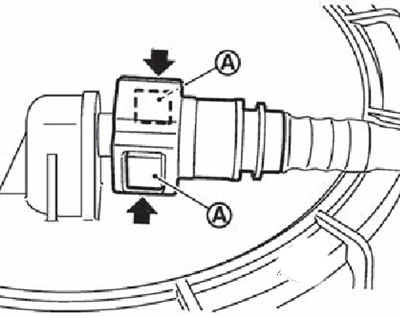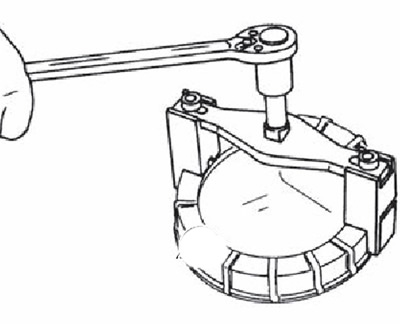Attention. Before starting work, you must carefully read the precautions for working on the car's power system.
Note. Below is a description of the procedures for the example of modifications with gasoline engines. Operations for diesel modifications are almost identical.
1. Check the fuel level at the pointer. If the fuel gauge shows a higher level than shown in the figure (complete or nearly complete), it is necessary to drain the fuel from the tank to the level shown in the figure.

Note.
- If this is not done, then when removing the main and additional fuel sensors, fuel will spill from the tank.
- For reference: the fuel level sensor will take the position indicated in the figure after draining approximately 15 liters of fuel from the tank.
- If the fuel priming pump is not working, follow the procedure below:
- To drain the fuel from the filler neck, it is necessary to insert a hose with a diameter of no more than 20 mm into the filler neck.
- Disconnect the filler hose from the filler neck.
- Insert a hose into the tank through the filler neck to drain fuel from the fuel tank.
2. Depressurize the fuel lines (see chapter «Engine management system»).
3. Open the fuel filler hatch.
4. Unscrew the filler cap to release the pressure inside the fuel tank.
5. Remove the rear seat cushion.
6. Use a screwdriver to turn the latches by 90°and remove the service hatch cover.
7. Disconnect the electrical connector (A) and fuel line quick connector (IN).

Note. The arrow in the figure shows the front of the car.
Note.
- Removing the quick connector is done as follows:
- Pinch the squares with your fingers (A) and pull the quick connector.
- If the quick connector is stuck, move the connector back and forth several times to loosen it and remove it.

Attention.
- The quick connector can only be removed after the latches are fully compressed. Do not twist the connector more than necessary.
- Do not use a tool to remove the quick connector.
- Do not allow heating of polymer pipelines. Take special care when welding near plastic pipelines.
- Avoid contact with acids (e.g. battery electrolyte) for polymer pipelines.
- Do not kink or twist polymer tubing during installation or disconnection.
- To prevent damage and foreign particles from entering the connectors, completely cover them with plastic bags (A) or something similar.
- Do not insert plugs to avoid damaging the O-rings of the quick connectors.

8. Using the special tool, remove the retaining ring of the fuel level sensor module, fuel filter and fuel pump assembly by turning it counterclockwise.

Note. To install the fixing ring in its original place, it is recommended to mark the relative position before removal.
9. Remove the module (1) fuel priming pump with main fuel level sensor and fuel filter.

Attention.
- Be careful not to bend the float arm during removal.
- Be careful not to hit or drop parts.
- Do not allow foreign objects to enter the fuel tank. When removing parts, use linen cloth.
10. If equipped: Remove additional fuel level sensor assembly.
Attention.
- Do not remove the fuel line from the auxiliary fuel level sensor assembly.
- Be careful not to bend the float arm during removal.
- Do not allow foreign objects to enter the fuel tank. When removing parts, use linen cloth.
- Do not drop or hit the sensor.